AI code means more critical thinking, not less
PositiveArtificial Intelligence
Ryan discusses with Matias Madou, co-founder and CTO of Secure Code Warrior, the implications of large language models (LLMs) on code security and the evolving landscape of developer training. As AI coding assistants gain popularity, the conversation emphasizes the critical need for developers, particularly those at the junior level, to enhance their critical thinking skills. This shift is seen as essential in navigating the complexities introduced by AI technologies in software development.
— via World Pulse Now AI Editorial System




